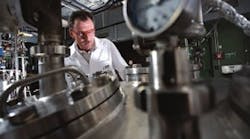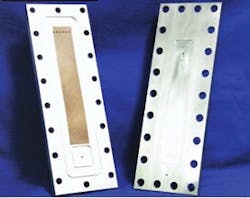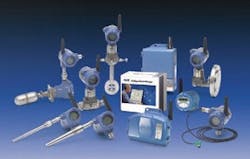The chemical plant of the future will differ considerably from today’s facilities.
It’ll be smaller, safer, more efficient, better controlled and use other feedstocks.
The Flexible, Fast and Future (F3) Factory initiative, which was launched on June 8 at Bayer Technology Services (BTS), Leverkusen, Germany, will offer a glimpse of what’s to come. It brings together 25 leading European chemical companies and research institutes into a project funded by the European Union (EU) and coordinated by BTS. The four-year, €30-million (about $42-million) effort aims to design and develop a modular continuous plant, to standardize processes and their interfaces, and to demonstrate the capabilities of the F3 Factory with existing products. The partners also intend to apply the efficiency and scalability of world-scale continuous plants to batch production facilities. Such moves could save the European chemical industry nearly €4 billion ($5.6 billion) and open up new markets, reckons the F3 Factory consortium.
“Today we are at the beginning of a trendsetting — and perhaps even revolutionary — cooperation within the European chemical industry, since F3 Factory combines the enormous process know-how of industry and research units in a to-date unique consortium across competitors,” notes Achim Noack, BTS managing director.
However, individual companies also are working on their own to plot a course for their future. For instance, consortium member BASF, Ludwigshafen, Germany, is working to develop a set of adapted plant concepts that address future needs. “If, for instance, market demand is expected to develop over a long timescale, a smaller plant with a built-in expansion option helps to avoid underutilization cost and market risk of a world-scale installation. The expansion can either be accomplished by designing multiple parallel trains or by including debottlenecking options into the design of the first plant. Another example is a plant designed to be adapted gradually to a changing product portfolio, allowing its continued use despite the limited lifecycle of the individual products,” explains Georg Grossmann, director, group engineering.
In addition, the company is tackling high energy costs associated with basic thermal separation processes such as distillation and extraction. “To assure its competitive position in a high-energy-cost environment, BASF is using advanced concepts to minimize the specific energy used for separation. Those include vapor recompression, optimized separation sequences using dividing wall columns [for details on this technology, see “Consider Dividing Wall Columns, and high performance packings, and computerized optimization methods for heat integration.”
Feedstock flexibility is a driving force in its research activities. For instance, working with Linde AG, Munich, Germany, BASF has developed a process for making propene from propane. The catalyst is achieving more than 93% selectivity in a propane dehydrogenation pilot plant at Ludwigshafen. Other examples include new synthesis routes for aromatics using an improved molybdenum-carbide catalyst system.
BASF also is heavily focused on biotechnologies for converting raw materials such as sugar and vegetable oil into chemical products (Figure 1). An important aspect of this is the use ionic liquids (Wood-based Chemicals Get Boost) to enable easier and cheaper processing of cellulose.
In 2009 the company is investing €300 million (about $421 million) in what it calls five “growth clusters” — energy management, raw material change, nanotechnology, plant biotechnology and white (industrial) biotechnology.
Energy-Efficient Distillation
The F3 Factory consortium and BASF certainly aren’t blazing a new trail in their efforts to reduce high energy costs associated with separation processes.
“The U.S. government has been trying to eliminate distillation for the last 40 years. It alleges that 3% of U.S. energy use is by distillation and they regard that as significant,” says Michael R. Resetarits, technical director of Fractionation Research Inc., Bartlesville, Okla. He points to two technologies that might provide substantial energy savings: heat-integrated distillation columns (HIDiC) and microchannel distillation.
“HIDiC represents the Holy Grail of distillation in that it attempts to achieve the separation via the minimum theoretical heat input,” notes Resetarits. By combining rectifying and stripping columns in an annular arrangement so they exchange heat along their lengths, and elevating pressure in the rectifying section, HIDiC can achieve energy savings of more than 50%.
A properly designed system can save up to 60% of the energy required for separation — and reduce condenser duty and, consequently, condenser size by up to 60%, concludes advanced modeling technology and model-based services provider Process Systems Enterprise (PSE), London, U.K., after investigating HIDiC using its proprietary gPROMS advanced process modeling software (http://www.psenterprise.com/gproms/applications/separation/hidic.html).
However, despite its promise, HIDiC remains a pilot process. “It has yet to be commercialized,” notes Professor Shuzo Ohe of the graduate school of engineering, industrial chemistry, University of Tokyo, Japan, who has worked with the technology for a number of years.
Meanwhile, development of microchannel distillation technology is progressing, e.g., at Velocys, Plain City, OH, part of Oxford Catalysts Group, Oxford, U.K. The approach aims to provide high efficiency mass transfer in a very small package.
Microchannel distillation differs from conventional distillation processes in that liquid and vapor phases flow counter-currently within a single thin vertical channel as opposed to in separate tall towers. Depending on the application, microchannel channel diameters range from 0.1 mm to 10 mm. Modules for small speciality chemical units may contain a single process channel while those for large-scale commodity plants might consist of thousands of process channels incorporated into a unit the size of a two-foot cube. In either case, capacity expansion simply involves “numbering up” or linking more modules together.
Microchannels adjacent to process channels can serve as integrated heat exchangers, doing away with the need for separate pieces of equipment and enabling simple control and optimization of temperature for the particular application.
Thin channels with small gaps and counter-current vapor and liquid flow lead to highly efficient mass transfer. Where a conventional column may require 60 cm to achieve a stage of separation, a microchannel distillation unit may provide the same separation in a distance of less than 1 cm (Figure 2).
Benefits of microchannel distillation include low capital and energy costs, simple capacity expansion, compact footprint and short hold-up time, which minimizes exposure of chemicals to temperatures required for distillation.
“In the near term, Velocys is looking for partners and applications for small-scale and pilot-scale uses of microchannel distillation,” says Larry Plonsker, a consultant for the company.
Of course, other techniques also may offer advantages. For instance, the European Federation of Chemical Engineering (EFCE), Frankfurt, Germany, on June 17 awarded its coveted EFCE Excellence Award in Process Intensification for` 2009 to Carsten Buchaly for his Ph.D. thesis on the optimization of a hybrid process combining reactive distillation with vapor permeation. However, Buchaly, now with BTS in Leverkusen, cautions that lack of more advanced tools for predictive simulation is hampering development of this “very promising” technology.
Untouchable Advances
Virtual reality and wireless data transmission may be physically hard to grasp — but their impact on plants won’t be.
Immersive virtual reality plant (IVRP) is very much a coming technology, believes Maurizio Rovaglio, Milan, Italy, -based vice president solutions services, EMEA, for Invensys Process Systems (IPS). Users, who initially focused on control room training, now consider IVRP as a serious cost-reduction tool, he says.
“One of the main issues is plant safety. Twenty-five percent of all the money spent by a refinery on training its staff goes on safety. But customers say they don’t really have a tool that does this effectively because so many solutions are passive. Using IVPR, staff can also see inside processes (vessels, reactors, burners and so on) and actually see fouling, for example, in progress.”
The technology can speed training. “IVPR is also an important and effective way to cut the need for so much on-the-job training. We think we can cut this by up to 50%; so new staff can reach the required standard in six months rather than a year,” notes Rovaglio.
IVPR also can lead to operational and maintenance benefits. One IPS customer requires eight hours to start up its steam reformer because 250 tasks — 120 in the field —need to be completed before and during the procedure. IPS believes IVPR can cut this time by one to two hours. “Overall, we can save between 1 and 3% of a maintenance budget, which is huge money,” he says,
Wireless technology also should gain far wider use (see “Whither Wireless"). Many plants won’t need much convincing. In a recent CP online poll, nearly 60% of respondents rated their site’s interest in wireless as “high” or “very high.” The technology offers enhanced capabilities for condition monitoring, troubleshooting and much more, providing benefits to operators, process engineers and plant managers.
Adding to the impetus, vendors continue to expand their wireless offerings. For instance, Emerson Process Management, Austin, Texas, just added discrete switches plus vibration and pH transmitters to its Smart Wireless field starter kit (Figure 3). “This kit makes it very simple and low risk to try Smart Wireless,” notes Bob Karschnia, vice president of wireless technology. “Companies who’ve never used this technology before can quickly and easily begin to reap the same benefits gained by their peers who are already using Smart Wireless.”
More Collaboration
The future also will see greater collaboration between disciplines and within disciplines through increased leveraging of process engineering tools, notes David Tremblay, senior product manager at AspenTech, Burlington, Mass.
“Information will be stored in a shared database, accessed through light for-purpose interfaces served over the web. Audit tracking, case management and role-based security will be built in seamlessly with the underlying applications,” he says.
So, for instance, thermodynamics experts will have easy access to a wide range of public and proprietary physical property data. High quality predictions from molecular simulation will fill gaps in measured data. Next-generation equations of state will be able to represent a wider range of processes and process conditions.
At the same time, ongoing research will enable better characterization of complex materials, e.g., fluids such as petroleum and solids such as coal and biomass. This will provide a firm foundation for true “molecule management” from source to product.
“A common data model for equipment, materials, process streams and process economics will serve as the framework for the next-generation modeling tools. As the process design evolves, the data model will get populated with a richer and more complete set of information. This will enable increasingly accurate estimates of process capital and operating costs throughout the product lifecycle,” predicts Tremblay.
The scale of process models will continue to grow, he believes, until a single model captures an entire production site. “Many different engineers may collaborate to build individual sections of the model, perhaps at different levels of rigor,” he notes.
Security And Safety
Greater amount of data, increased collaboration among groups, and expanded communication between disparate information systems will ratchet up demands for cyber security and plant safety.
“Chemical facilities have traditionally been physically and electronically isolated from the outside world to ensure safe production and distribution of chemical products. Though there will always be a robust physical cyber-security posture to protect these potentially dangerous facilities, the need for real-time information and productivity efficiency gains are driving open connectivity to the chemical facility network,” says Todd Nicholson, chief marketing officer of Industrial Defender, Foxborough, Mass., a firm that’s completed more than 100 process control/SCADA cyber-security assessments around the world.
Convergence of information technology (IT) and plant operations spheres opens up formerly closed systems to a host of cyber risks and vulnerabilities that were never an issue when those systems were air-gapped, Nicholson notes. Plant-level devices now are enabled to support TCP/IP and IT-based technology platforms; employees and vendors require secure remote access for equipment monitoring and maintenance; and wireless LAN technologies are proliferating on sites. Internet access is a given.
“The open protocols required for improved efficiencies in field automation carry their own risks, as do the movement away from proprietary legacy protocols such as Fieldbus in favor of Ethernet-based standards. And the ongoing convergence between physical and cyber security requires a high degree of information protection. These imperatives and more point to the increasing requirement for a robust cyber security posture addressing current and future threats,” he cautions.
Safety also demands robust measures, stresses the European Process Safety Centre (EPSC), Rugby, U.K., an organization that promotes best practices for both prevention and mitigation of chemical accident hazards.
“The fundamental safety challenge to confront the major hazards industries is to drive down the rate of process safety incidents such as leaks and spills caused by loss of containment,” says Lee Allford, manager — EPSC operations. “It sounds simple but, in fact, although there is evidence to suggest that there are fewer year-on-year incidents those that do occur tend to be more deadly, cause more damage and grab more headlines.”
However, Allford believes that in the wake of the BP Texas City disaster (http://www.ChemicalProcessing.com/articles/2006/055.html) industry now generally accepts the need to put in place an early warning system for such accidents — including a full monitoring program of loss-of-control events such as tank overfills and breaches of layers of protection that must be considered as potentially serious incidents.
“Action is not easy and requires dedicated and reforming leadership. Of course, of equal importance is to ensure that senior management set the right tone at the top for safety, provide resourcing, and drive safety issues to satisfactory resolution. Collectively, high hazards organizations will need to network, share learning experiences on incidents — the ‘know why’ as well as the ‘know how’ — in order to advance in the journey to zero accidents,” he concludes.
Seán Ottewell is Chemical Processing's Editor at Large. You can e-mail him at [email protected].




